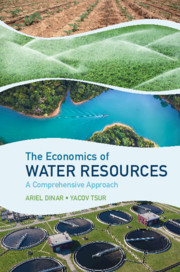Book contents
- The Economics of Water Resources
- The Economics of Water Resources
- Copyright page
- Contents
- Figures
- Tables
- Acknowledgments
- Introduction and Outlook
- Chapter 1 The State of Water Resources and the Need for a Comprehensive Perspective
- Chapter 2 The Water Economy
- Chapter 3 Supply Costs, Demands and Benefits
- Chapter 4 Optimal Water Policy
- Chapter 5 Water Regulation
- Chapter 6 Accounting for Uncertain Water Supplies
- Chapter 7 Case Studies of Regulatory Interventions
- Chapter 8 Economy-Wide Considerations of Water Management
- Chapter 9 Management of Transboundary Waters
- Index
- References
Chapter 9 - Management of Transboundary Waters
Published online by Cambridge University Press: 21 April 2021
- The Economics of Water Resources
- The Economics of Water Resources
- Copyright page
- Contents
- Figures
- Tables
- Acknowledgments
- Introduction and Outlook
- Chapter 1 The State of Water Resources and the Need for a Comprehensive Perspective
- Chapter 2 The Water Economy
- Chapter 3 Supply Costs, Demands and Benefits
- Chapter 4 Optimal Water Policy
- Chapter 5 Water Regulation
- Chapter 6 Accounting for Uncertain Water Supplies
- Chapter 7 Case Studies of Regulatory Interventions
- Chapter 8 Economy-Wide Considerations of Water Management
- Chapter 9 Management of Transboundary Waters
- Index
- References
Summary
The chapter surveys the literature and approaches that deal with the economics and politics of managing internationally shared water resources (aka transboundary water). Principles that are relevant to the analysis of management of shared international water are discussed and demonstrated. One aspect that is unique to international water is the use of agreements between all or part of the riparian states that share the basin. The chapter introduces several means by which cooperation among the riparian states is defined and calculated, using the information embedded in the treaties that they signed. The chapter provides also an example, applied to the case of the Blue Nile Basin, of the effect of using certain allocation methods on the welfare of the river basin riparian states, Ethiopia, Sudan, and Egypt, and its effects on the stability of their allocation agreement.
Keywords
- Type
- Chapter
- Information
- The Economics of Water ResourcesA Comprehensive Approach, pp. 190 - 206Publisher: Cambridge University PressPrint publication year: 2021

